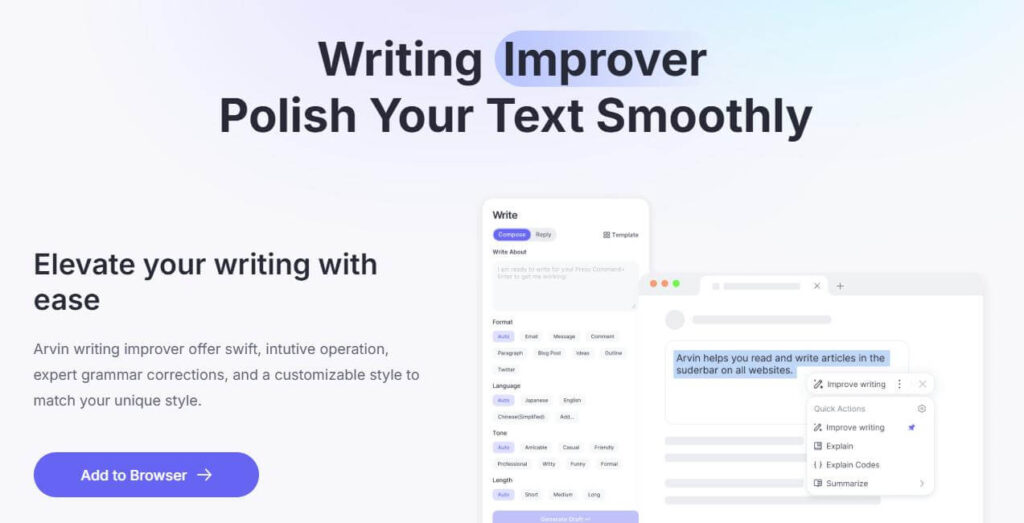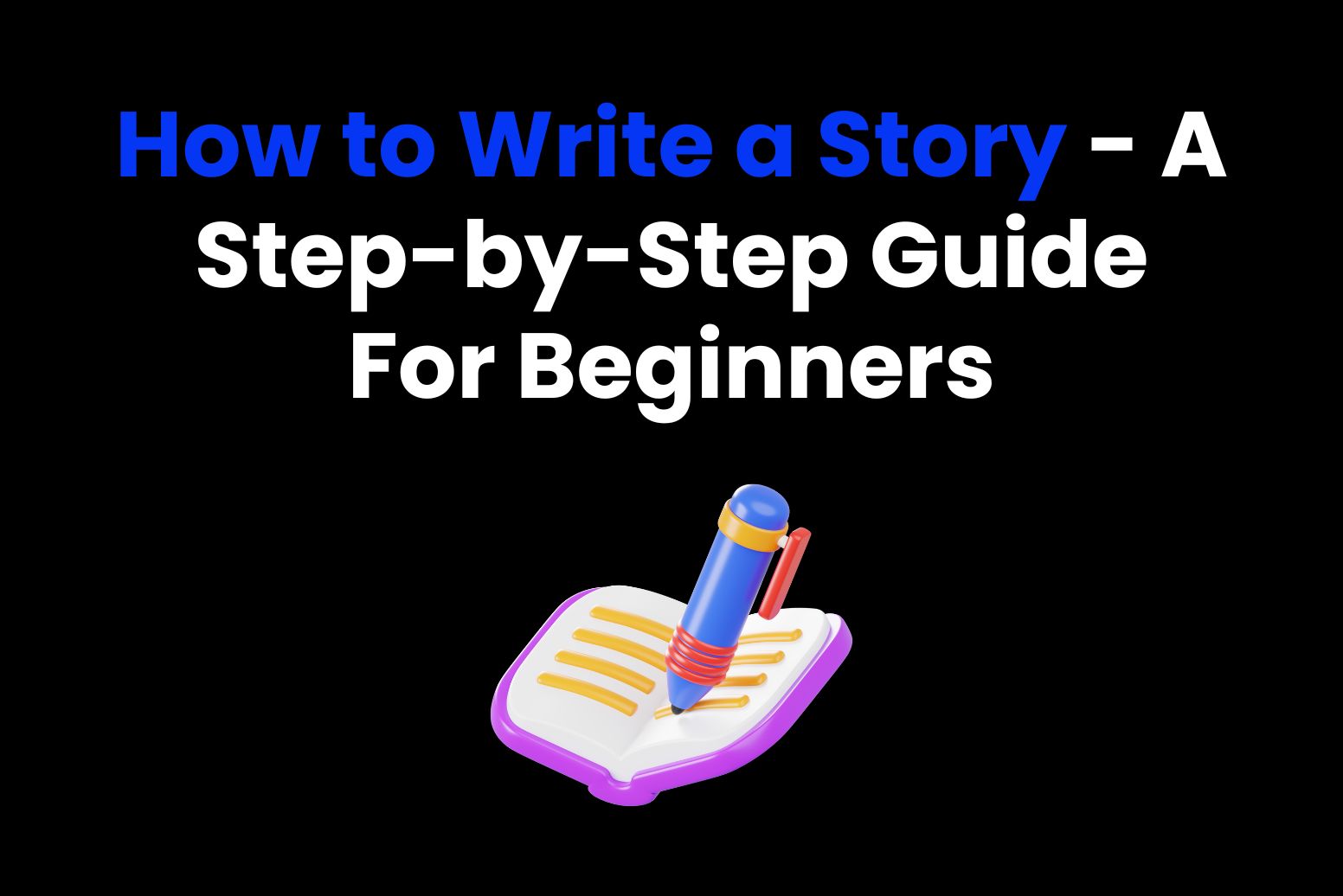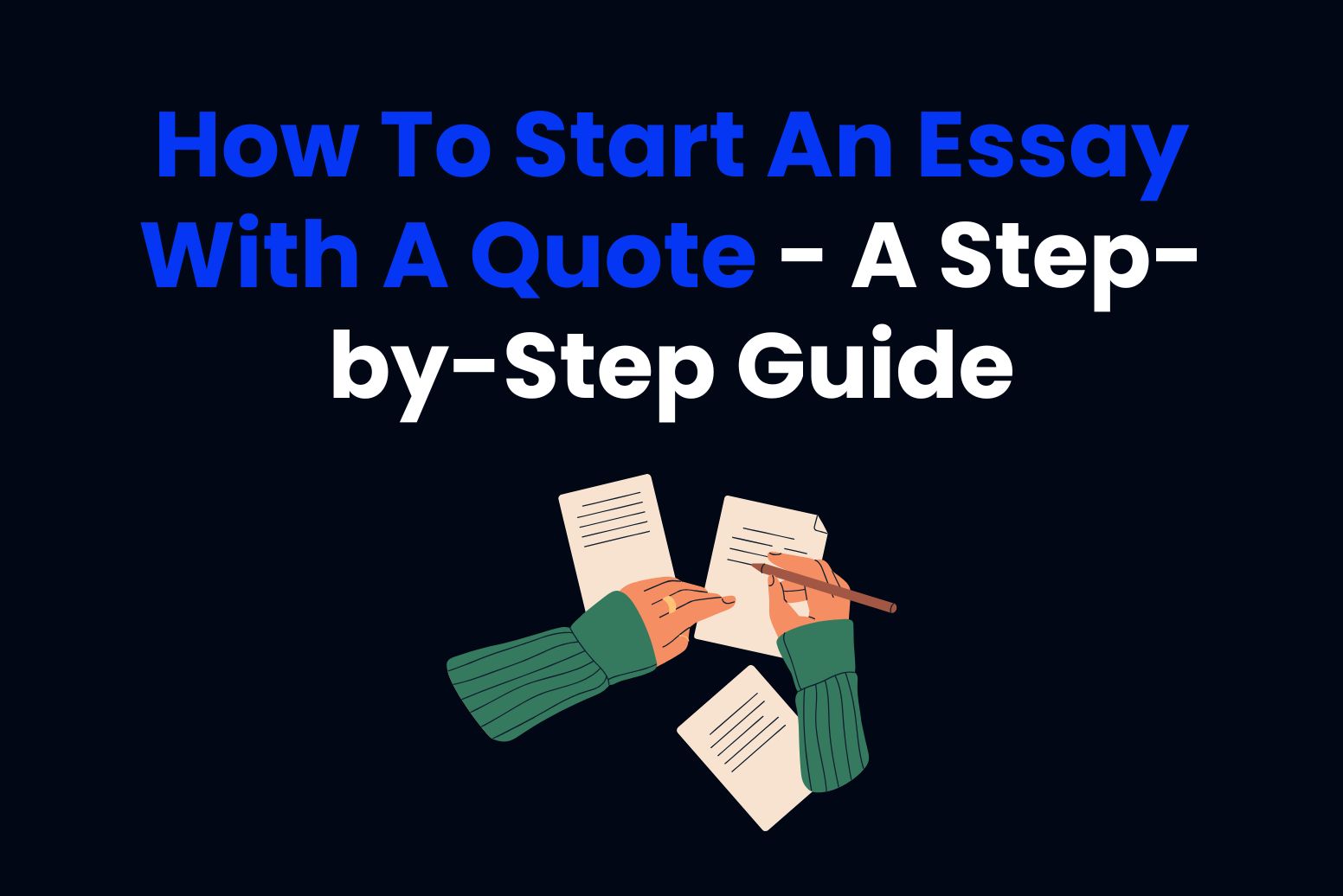Every great story begins with a single sentence, and how you start that sentence can make all the difference. Knowing how to start a sentence by crafting compelling sentence openers not only grabs the reader’s attention but also sets the tone, builds intrigue, and draws them deeper into your narrative.
Need help finding the right words? With Arvin AI, you can create vivid sentences, imaginative plots, and unforgettable stories—all at the click of a button. Begin your journey toward better storytelling now!
Why Are Sentence Starters Important?

How to start a sentence? Sentence starters are the unsung heroes of effective writing. They do more than simply begin sentences—they provide structure, guide the reader, and set the tone for what’s to come.
Tips for Starting a Sentence
1. Use Transition Words for Smooth Flow
Incorporate words like “Moreover,” “Meanwhile,” or “Nevertheless” to connect your ideas. These transitions help your sentences flow naturally and make the relationship between them clearer.
2. Highlight an Action With an “-ing” Word
Words ending in “-ing” (gerunds) create a sense of motion or immediacy.
For example: “Running toward the finish line, he felt his heart race.”
3. Begin With a Prepositional Phrase
Adding a prepositional phrase at the start can provide context or paint a scene.
For instance: “Across the meadow, the deer moved silently.”
4. Open With a Thought-Provoking Question
Engage your reader by beginning with a question.
For example: “What would you do if success was guaranteed?”
Questions make your writing interactive and invite the audience to think.
5. Start With a Clause for Depth
Kick off with a dependent clause to set up your sentence. Phrases like “While she waited” or “Although he hesitated” add complexity and give context before the main idea.
6. Highlight an Action With an “-ing” Word
Words ending in “-ing” (gerunds) create a sense of motion or immediacy.
For example: “Running toward the finish line, he felt his heart race.”
7. Use an “-ed” Word for Emphasis
Start with an emotion or reaction by using a past participle.
For example: “Exhausted by the day’s events, she collapsed into bed.”
8. Lead With an Adverb or Descriptive Phrase
Add detail or mood by starting with an adverb like “Suddenly,” “Gratefully,” or “Softly.”
For example:“Softly, the waves kissed the shore.”
9. Begin With a Comparison or Imagery
Similes and metaphors are powerful ways to set a vivid scene.
For instance:“Like a rising tide, hope flooded her heart.“
10. Capture Attention With a Strong Statement
A bold statement or fact can grab attention immediately.
For example: “The most dangerous threats are often the ones you can’t see.”
11. Keep It Simple and Direct
Sometimes, less is more. A short, straightforward sentence can deliver impact.
For instance: “He decided to leave.”
Minimalist openers work especially well in dramatic or reflective writing.
How to Start a Sentence in an Essay?
Different types of essays require unique sentence openers tailored to their purpose and audience. Here’s a breakdown of common essay types and examples of sentence openers that suit each style.
1. Argumentative Essay
Purpose: To persuade the reader of a specific stance or viewpoint by presenting evidence and reasoning.
Effective Sentence Starters:
- Use transitional phrases to connect arguments.
- Begin with data, claims, or rhetorical questions to engage the reader.
Examples:
- “According to recent data, renewable energy adoption has increased by 40% in the last decade.”
- “What are the ethical implications of artificial intelligence in decision-making?”
- “Despite its benefits, this policy raises critical questions about equity and accessibility.”
2. Expository Essay
Purpose: To inform or explain a topic clearly and concisely, often using factual information.
Effective Sentence Starters:
- Begin with definitions, facts, or cause-effect relationships to establish the context.
- Use straightforward transitions like “Firstly,” “For example,” or “In addition.”
Examples:
- “Data encryption refers to the process of converting information into a secure format to prevent unauthorized access.”
- “For example, the rise of remote work has reshaped traditional office dynamics.”
- “As a result of industrialization, urban populations grew exponentially in the 20th century.”
3. Descriptive Essay
Purpose: To vividly describe a person, place, object, or experience, engaging the reader’s senses.
Effective Sentence Starters:
- Use imagery and sensory details to paint a picture.
- Start with a metaphor or simile for creative impact.
Examples:
- “The forest floor glistened like a mosaic of emeralds after the morning rain.”
- “Quiet as a whisper, the snow blanketed the town in serene white.”
- “Beneath the golden sunset, the waves danced to the rhythm of the wind.”
4. Narrative Essay
Purpose: To tell a story, often using personal experiences or creative elements to engage the reader.
Effective Sentence Starters:
- Begin with dialogue, action, or a surprising fact to draw readers into the story.
- Use chronological markers like “Later,” “That day,” or “As the sun set.”
Examples:
- “‘I can’t believe it,’ she said, her voice trembling with excitement.”
- “Running through the alley, I could hear the distant sirens closing in.”
- “That summer, everything changed when we moved to the countryside.”
5. Compare and Contrast Essay
Purpose: To analyze the similarities and differences between two or more subjects.
Effective Sentence Starters:
- Use comparative phrases like “Similarly,” “In contrast,” or “While both share.”
- Begin with specific observations to frame the comparison.
Examples:
- “While renewable energy reduces carbon emissions, its implementation faces logistical challenges.”
- “In contrast to traditional education models, online learning offers greater flexibility.”
- “Both smartphones and tablets provide portability, but they differ significantly in functionality.”
6. Cause and Effect Essay
Purpose: To explain how one event or action leads to another.
Effective Sentence Starters:
- Use phrases like “Because of,” “As a result,” or “This led to.”
- Start with observations or outcomes related to the topic.
Examples:
- “Because of advancements in medicine, life expectancy has increased dramatically.”
- “As a result of climate change, sea levels are rising at an unprecedented rate.”
- “This led to widespread reform across industries, reshaping workplace policies.”
7. Reflective Essay
Purpose: To analyze personal experiences and their impact or significance.
Effective Sentence Starters:
- Begin with introspective phrases like “I realized,” “Looking back,” or “It was then.”
- Use descriptive details to set the mood.
Examples:
- “Looking back, I now understand how that moment shaped my outlook on life.”
- “It was then I realized the importance of perseverance in overcoming challenges.”
- “Walking through those halls for the last time, a wave of nostalgia washed over me.”
How to Start a Sentence for Kids?
1. Begin With Action Words
Action words (verbs) make sentences exciting and dynamic, immediately drawing the reader in.
Examples:
- “Jumping into the puddle with a loud splash, she laughed as the water soaked her boots and jeans.”
- “Running to the park with his kite in hand, he saw his friends waving and calling his name.”
2. Use Sound Words
Sound words (onomatopoeia) grab attention and make the story feel alive by appealing to the reader’s senses.
Examples:
- “Boom! The fireworks lit up the night sky, painting it with streaks of red and gold.”
- “Whoosh! The strong wind swept the leaves high into the air, scattering them like tiny dancers.”
3. Start With “When” or “Where”
Starting with time or place helps kids set the scene and provides context for the story.
Examples:
- “In the middle of the forest, where the trees grew thick and tall, they discovered a hidden trail covered with moss.”
- “Yesterday afternoon, while the sun was setting, I spotted the most colorful rainbow stretching across the sky.”
4. Begin With a Question
Questions create curiosity and pull readers into the story by making them think.
Examples:
- “What would you do if you found a treasure chest buried under your backyard?”
- “Have you ever wondered how birds can fly so high without getting tired?”
5. Use Describing Words
Starting with adjectives or adverbs adds color and detail to sentences, making them more vivid.
Examples:
- “Bright and colorful like a carnival, the balloons floated high into the sky, carried by the gentle wind.”
- “Carefully, as if she were painting a masterpiece, she dipped her brush into the brightest shade of blue.”
6. Start With a Feeling
Beginning with emotions connects readers to the character’s experience and makes the writing relatable.
Examples:
- “Excited beyond words, I couldn’t wait to open my birthday presents and see what surprises were inside.”
- “Nervous about the first day of school, he clutched his backpack tightly and walked into the classroom.”
7. Use “I” Statements for Personal Writing
For personal essays or journals, starting with “I” is straightforward and helps kids share their experiences.
Examples:
- “I love playing soccer with my friends because it makes me feel like part of a team, especially when we win!”
- “I went to the zoo last weekend, and the tiger was the most amazing animal I saw—it was so big and powerful.”
8. Begin With Dialogue
Dialogue can make stories more interactive, bringing characters to life right from the start.
Examples:
- “‘Let’s go on an adventure to find the lost treasure!’ Max exclaimed, grabbing his map and flashlight.”
- “‘Look at that butterfly!’ she shouted, pointing to the bright orange wings fluttering by the garden.”
9. Use Fun Comparisons
Similes and metaphors spark imagination by comparing familiar things in creative ways.
Examples:
- “Like a rocket blasting into space, the dog raced across the field to catch the ball.”
- “As quiet as a mouse, he tiptoed into the kitchen, hoping to grab a cookie without waking anyone.”
10. Keep It Simple With Subject Openers
Starting with the subject makes sentences clear and easy to understand, which is great for younger kids.
Examples:
- “The cat curled up on the windowsill, purring softly as the warm sunlight bathed its fur.”
- “The stars twinkled brightly in the night sky, making it look like a magical painting.”
How to Start a Sentence in a Story?
Why let good ideas go to waste? With Arvin AI, you can craft sentences that grab attention and keep readers hooked. Start creating your best work now!
1. Use Action to Create Momentum
Starting with an action immediately draws the reader into the story and sets the pace.
Examples:
- “Running through the dark forest, she could hear the crunch of leaves underfoot.”
- “The door slammed shut behind him, leaving only silence in its wake.”
2. Begin With Dialogue
Dialogue immerses the reader in the scene and can reveal a lot about your characters.
Examples:
- “‘I told you this was a bad idea,’ she whispered, glancing nervously over her shoulder.”
- “‘Look at that sky!’ he exclaimed, pointing toward the streaks of orange and pink on the horizon.”
3. Start With a Question
Questions pique curiosity and make the reader want to know more.
Examples:
- “How could everything have gone so wrong in just one night?”
- “What was hiding behind that locked door?”
4. Use Vivid Descriptions to Set the Scene
Descriptive openings help the reader visualize the setting and establish the tone.
Examples:
- “The garden was alive with the sound of chirping crickets and the sweet scent of blooming jasmine.”
- “The abandoned house loomed over the street, its broken windows reflecting the pale moonlight.”
5. Introduce a Character’s Thoughts or Feelings
Starting with internal monologue or emotions gives the reader an immediate connection to the character.
Examples:
- “Her heart pounded as she stepped onto the stage, the lights blinding her for a moment.”
- “He couldn’t shake the feeling that someone was watching him.”
6. Use a Comparison or Metaphor
Metaphors and similes can create strong imagery and add depth to your storytelling.
Examples:
- “Like a predator stalking its prey, the shadow crept closer.”
- “Her smile was as bright as the morning sun, warming everyone around her.”
7. Open With an Unexpected Statement
A surprising or bold opening grabs the reader’s attention and adds intrigue.
Examples:
- “The letter had only four words, but they changed everything: ‘I know your secret.’”
- “No one in the small town expected the storm to hit that night.”
8. Start With Time or Place
Opening with a specific time or location sets the context and grounds the reader in the story.
Examples:
- “At dawn, the village was eerily quiet, the usual hustle and bustle replaced by a strange stillness.”
- “On the edge of the cliff, the old lighthouse stood guard against the raging sea.”
9. Introduce Conflict or Tension
Starting with a hint of conflict hooks the reader and sets the stage for the story’s main events.
Examples:
- “The argument was still ringing in her ears as she packed her bag and walked out the door.”
- “He knew he shouldn’t open the envelope, but curiosity got the better of him.”
10. Keep It Simple and Mysterious
Sometimes, a short and mysterious sentence is the most powerful way to begin.
Examples:
- “The phone rang once and then stopped.”
- “He was gone.”
Final Words
Starting sentences in a story is more than just an exercise in creativity—it’s a way to bring your world and characters to life.
With techniques like using vivid imagery, action-packed verbs, and thought-provoking questions, you can create openings that hook readers from the very first line. This way, you can know how to start a sentence that draws your reader in.
Remember, variety is key—mix descriptive details with dialogue, conflict, and surprising twists to keep your narrative engaging. And don’t be afraid to experiment and play around with how to start a sentence! Every sentence you craft is a chance to invite readers into your story and keep them eagerly turning the pages. The next great sentence—and story—starts with you.

Struggling to find the perfect way to start your sentences or craft an engaging story? With Arvin AI’s writing tools, you can effortlessly generate creative ideas, refine your sentences, and enhance your storytelling.
FAQ
A good way to start a sentence is by using a transition word, an action verb, or a descriptive phrase that connects it to the context of the previous sentence.
A good opening sentence grabs attention and sets the tone. For example, “On a quiet morning, the sun rose slowly over the hills, casting golden light on the valley” introduces a serene setting that pulls readers in.
A strong first sentence establishes the main idea or theme of the writing. For instance, in an essay about climate change: “Climate change is not a distant threat—it’s a challenge we must tackle today.” For storytelling, you might use: “It all began on the stormiest night of the year.”
Here are 10 examples of engaging sentences for different contexts:
“The stars twinkled like diamonds against the velvet sky.”
“As the door creaked open, a wave of cold air swept into the room.”
“Technology has transformed the way we live, work, and connect.”
“With a loud splash, the child jumped into the puddle, laughing with glee.”
“In the heart of the city, life moved at a relentless pace.”
“What would you do if tomorrow was your last day on Earth?”
“Quietly, she placed the note on his desk and walked away.”
“Behind the mountains, the sun dipped below the horizon, painting the sky in shades of pink.”
“Although the task seemed impossible, they refused to give up.”
“Boom! The fireworks lit up the sky in dazzling colors.”






